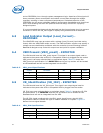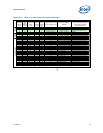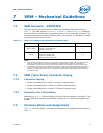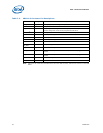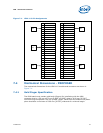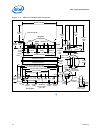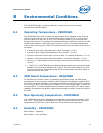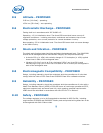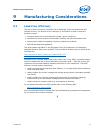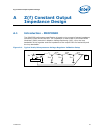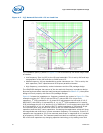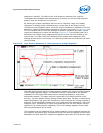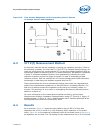
Environmental Conditions
46 315889-002
8.5 Altitude - PROPOSED
3.05 km [10 k feet] – operating
15.24 km [50 k feet] – non-operating
8.6 Electrostatic Discharge - PROPOSED
Testing shall be in accordance with IEC 61000-4-2.
Operating – 15 kV initialization level. The direct ESD event shall cause no out-of-
regulation conditions – including overshoot, undershoot and nuisance trips of over-
voltage protection, over-current protection or remote shutdown circuitry.
Non-operating –25 kV initialization level. The direct ESD event shall not cause damage
to the VRM circuitry.
8.7 Shock and Vibration - PROPOSED
The shock and vibration tests should be applied at the baseboard level. The VRM/EVRD
should not be damaged and the interconnect integrity not compromised during:
• A shock of 50 g (± 10%) with velocity change of 170 inches/sec (± 10%) applied
three times in each of the orthogonal axes.
• Vibration of 0.01 g² per Hz at 5 Hz, sloping to 0.02 g² per Hz at 20 Hz and
maintaining 0.02 g² per Hz from 20 Hz to 500 Hz for 10 minute per axis applied in
each of the orthogonal axes.
8.8 Electromagnetic Compatibility - PROPOSED
Design, including materials, should be consistent with the manufacture of units that
comply with the limits of FCC Class B and CISPR22 Class B for radiated emissions.
8.9 Reliability - PROPOSED
Design, including materials, should be consistent with the manufacture of units with a
Mean Time Between Failure (MTBF) of 500,000 hours of continuous operation at 55ºC,
maximum-outputs load, and worst-case line, while meeting specified requirements.
MTBF should be calculated in accordance with MIL-STD-217F or Bellcore.
8.10 Safety - PROPOSED
The voltage regulator is to be UL Recognized to standard UL1950 3rd Ed., including
requirements of IEC950 and EN 60950. Plastic parts and printed wiring board are to be
UL Recognized with 94V-0-flame class.
§



